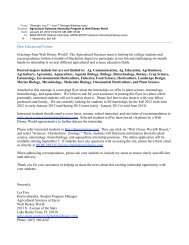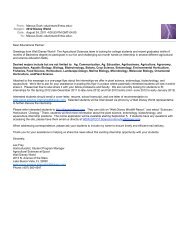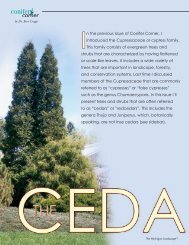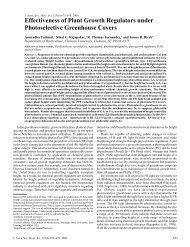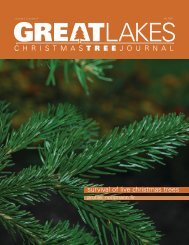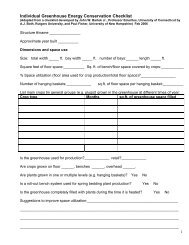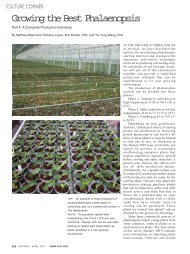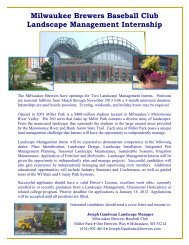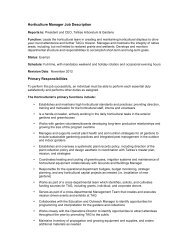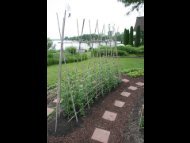Container Production for Living Christmas Trees - Department of ...
Container Production for Living Christmas Trees - Department of ...
Container Production for Living Christmas Trees - Department of ...
- No tags were found...
You also want an ePaper? Increase the reach of your titles
YUMPU automatically turns print PDFs into web optimized ePapers that Google loves.
container productionwinter 2009great lakes christmas tree journal<strong>Container</strong> <strong>Production</strong> <strong>for</strong> <strong>Living</strong> <strong>Christmas</strong> <strong>Trees</strong>Bert Cregg, Wendy Klooster, Amanda Taylor, R. Thomas Fernandez and Pascal Nzokou, Michigan State University, <strong>Department</strong><strong>of</strong> Horticulture, <strong>Department</strong> <strong>of</strong> Forestry<strong>Living</strong> <strong>Christmas</strong> trees are an increasinglypopular niche market <strong>for</strong> many<strong>Christmas</strong> tree growers and tree nurseries.Although no <strong>of</strong>ficial statistics areavailable on sales <strong>of</strong> living <strong>Christmas</strong>trees, a walk through a garden center ora perusal <strong>of</strong> specialty catalogs such asJackson and Perkins shows an everincreasingarray <strong>of</strong> living <strong>Christmas</strong> treesavailable. Several university extensionservices such as Clemson and Purduenow publish guidelines <strong>for</strong> care and handling<strong>of</strong> living <strong>Christmas</strong> trees <strong>for</strong> consumersthat want to plant their trees afterthe holidays. In the western United States,companies now <strong>of</strong>fer “rental” <strong>Christmas</strong>tree services that bring living trees intohomes <strong>for</strong> holiday display and then pickup the trees after <strong>Christmas</strong> and plantthem in parks and schools.Marketing living trees that consumerscan plant after the holidays is not newand many <strong>Christmas</strong> tree growers havedug and sold a portion <strong>of</strong> their crop asliving trees <strong>for</strong> years. The reasons consumerschoose living trees are varied;Table 1. Approximate Weight <strong>of</strong> Soil in Root-balls <strong>of</strong> Field-dug ConifersTree height Minimum Root-ball diameter 1 Root-ball weight 2(feet) (inches) (pounds)3 18 60–704 20 80–1005 22 110–1306 24 140–1707 26 180–2108 28 230–260some consumers consider living treesmore environmentally friendly than cuttrees,some like the ‘two-<strong>for</strong>-one’ aspect <strong>of</strong><strong>Christmas</strong> trees that can also be plantedin the landscape, some plant trees tomark special occasions such a child’sfirst <strong>Christmas</strong>. A major challenge <strong>for</strong>consumers purchasing field-dug trees,however, is that the root-ball <strong>of</strong> even amodest-sized living tree can weigh 100lbs or more (Table 1).<strong>Container</strong>-grown conifers<strong>Container</strong> production systems <strong>of</strong>fergrowers a means to produce lighterweightliving <strong>Christmas</strong> trees that are easier<strong>for</strong> typical consumers to handle.Growing <strong>Christmas</strong> trees in containersfollows the trend found in the landscapenursery market. According to a 2007 U.S.<strong>Department</strong> <strong>of</strong> Agriculture survey, containerproduction accounted <strong>for</strong> 53% <strong>of</strong>total landscape conifer nursery productionin 2006, up from 46% just three yearsearlier. At the same time, balled and burlapproduction dropped from 49% to 42%<strong>of</strong> the market.Moving from field production to containerproduction may seem like an easytransition , but the differences between37
container productionwinter 2009great lakes christmas tree journalMSU graduate research assistant Amanda Taylor is investigating growth and water use <strong>of</strong> container-grown conifers in response tocyclic irrigation.38field-growing and container-growing areso vast the best advice <strong>for</strong> would-be containergrowers may be, “Forget everythingyou know.” While all <strong>of</strong> the subtleties <strong>of</strong>container production can fill volumes,the three most important factors growersneed to consider are: container substrates,irrigation management, and nutritionmanagement. These factors can beconsidered as a ‘three-legged stool’ andeach one must be properly managed toproduce a quality crop.<strong>Container</strong> substratesOne <strong>of</strong> the biggest challenges <strong>for</strong><strong>Christmas</strong> tree producers accustomed t<strong>of</strong>ield production is understanding theimportance <strong>of</strong> container substrates.Choice <strong>of</strong> substrates will influence allother aspects <strong>of</strong> managing the crop.Many first-time container growers are surprisedto learn that container substratestypically do not contain any soil. Themost common elements are light-weightmaterials including pine bark, Douglas-firbark, peat moss, perlite, coconut hullsand composted materials such as ricehulls. In the southern U.S. several universitiesare researching the use <strong>of</strong> woodchips as an alternative to pine bark,which is becoming more expensive as itis diverted to other uses such as fuel andlandscape mulch. Regardless <strong>of</strong> thematerial chosen, the desired properties<strong>of</strong> container substrates are: moistureholding capacity, porosity (adequate airspace and drainage), weight (lighter isusually better), cost, and availability. Fora wide range <strong>of</strong> plants, mixtures <strong>of</strong> pinebark and peat moss provide an excellentcontainer substrate. We recently comparedgrowth <strong>of</strong> four conifer species(Fraser fir, Colorado blue spruce, Blackhills spruce and eastern white pine)planted as 2+2 transplanting into 3-galloncontainers. The plants were grown <strong>for</strong>two years in three ratios <strong>of</strong> pine bark andpeak moss (90% pine bark: 10% peatmoss, 80:20 and 70:30). <strong>Trees</strong> <strong>of</strong> all fourspecies grew well in the intermediate(80:20) mix (Figure 1). The fir andspruce trees also grew well in the heavy(70:30) mix while pines grew well in thelight (90:10) mix.Irrigation managementProper watering is essential to containertree production. In contrast t<strong>of</strong>ield production, where rainfall may providesufficient moisture, container-growntrees must be irrigated because <strong>of</strong> theirlimited rooting volume. Typically container-growntrees are watered every dayduring the growing season, particularly inmid-summer when temperatures are attheir peak. Depending on the size <strong>of</strong> thecontainers, irrigation may be provided byoverhead systems or by drip or microsprinkler(spray stakes) systems.Typically landscape container nurseriesuse overhead <strong>for</strong> 5-gallon containers orsmaller but some nurseries will use drip
container productionwinter 2009great lakes christmas tree journal40Figure 1. Averagestem caliper <strong>of</strong> living<strong>Christmas</strong>trees grown in3-gallon containers<strong>for</strong> two yearsin substrates withvarying ratios <strong>of</strong>pine bark andpeat moss.Figure 2. Averageone-year calipergrowth <strong>of</strong> easternwhite pine treesgrown in 3-galloncontainers at threeirrigation levelsapplied by dripemitters or spraystrakes. Dailyirrigation amountapplied once dailyat 6 am or appliedas 4 cycles at 6 am,10 am, 2 pm and6 pm.Figure 3. Averagetwo-year heightgrowth <strong>of</strong> living<strong>Christmas</strong> treesgrown in 3-galloncontainers inresponse to varyingrates <strong>of</strong> fertilizer.Fertilizer wasapplied as controlledrelease product(Osmocote 15-9-12 (N-P-K) 8-9month Northernrelease, Scott, Inc.)or spray stakes on smaller stock especiallyin Pot-in-Pot systems. The advantage <strong>of</strong>overhead irrigation is the low initial costand ease <strong>of</strong> installation. The disadvantage<strong>of</strong> overhead irrigation is the lower wateruse efficiency compared to drip or microsprinklerirrigation since overhead systemsirrigate the space between plantsand they also lose more water to evaporation.Drip and micro-sprinkler systems arevery efficient at applying water to theplant root zone but are more expensive toinstall than overhead systems.Maintenance can also be an issue withdrip or micro-sprinklers; since each treehas its own emitter or spray stake, workersneed to walk tree rows regularly to inspectand replace emitters that are clogged ordamaged by animals.As noted earlier, growers can improvethe efficiency <strong>of</strong> water use by using dripirrigation or spray stakes instead <strong>of</strong> overheadirrigation. Water use can be furtherenhanced by cyclic irrigation. Researchin the South has shown that wateringnursery crops in small pulses 3 or 4 timesa day can improve plant growth comparedto applying to same total amount <strong>of</strong>water once a day. We recently installedan irrigation trial <strong>of</strong> container grown conifersat the MSU Pot-in-Pot ResearchNursery. Preliminary results from the firstyear <strong>of</strong> the two-year study indicate thatapplying four 4-minute cycles <strong>of</strong> irrigationper day can improve growth <strong>of</strong> living<strong>Christmas</strong> tree species compared to treesreceiving the same daily irrigation amountapplied as a single 16-minute cycle(Figure 2).Nutrition ManagementFertilization is the third essential component<strong>of</strong> container production. Sincecontainer media are essentially soil-lesssubstrates, growers must account <strong>for</strong> allessential plant elements in their fertilizerprogram. This is in contrast to field productionwhere growers may only need toadd nitrogen or specific deficit elementsto produce a successful crop. The mostcommon approaches to fertilizing con-



